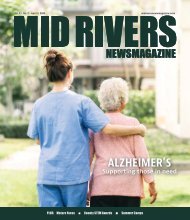Mid Rivers Newsmagazine 5-6-20
Local news, local politics and community events for St. Charles County Missouri.
Local news, local politics and community events for St. Charles County Missouri.
You also want an ePaper? Increase the reach of your titles
YUMPU automatically turns print PDFs into web optimized ePapers that Google loves.
<strong>20</strong> I HEALTH I<br />
May 6, <strong>20</strong><strong>20</strong><br />
MID RIVERS NEWSMAGAZINE<br />
@MIDRIVERSNEWS<br />
MIDRIVERSNEWSMAGAZINE.COM<br />
314.<strong>20</strong>5.6<strong>20</strong>0<br />
stlukes-stl.com/urgent-care<br />
8 a.m. to 8 p.m. Daily | Online Check-In<br />
On-site X-ray & Lab | No Appointment Necessary<br />
O’Fallon<br />
5551 WingHaven Boulevard<br />
O’Fallon, MO 63368<br />
½ mile north of Highway 40/I-64<br />
NOW OFFERING<br />
TELEHEALTH<br />
3-4359<br />
Early data is showing that asthma may not be as dangerous of a preexisting<br />
condition for COVID-19 as was first thought – but people with asthma should<br />
have a plan to keep the disease in check.<br />
[Source: Adobe Stock]<br />
Health<br />
Capsules<br />
By LISA RUSSELL<br />
Asthma and COVID-19:<br />
What are the risks?<br />
Health experts have repeatedly warned<br />
of the potential for more serious outcomes<br />
from COVID-19 for people of all ages<br />
with asthma and other preexisting lung<br />
problems.<br />
These warnings now coincide with<br />
National Asthma and Allergy Awareness<br />
Month in May, the height of the spring<br />
allergy season and generally the most<br />
challenging month of the year for the 7.7<br />
million American adults and children with<br />
asthma … even without the added threat<br />
of a global pandemic. A current shortage<br />
of asthma inhalers in certain parts of the<br />
country, caused by a spike in there use to<br />
treat hospitalized COVID-19 patients, may<br />
be adding to anxiety among asthma sufferers.<br />
However, it is important to note that<br />
so far at least, there is little evidence of<br />
increased infection or death rates in people<br />
with asthma.<br />
In April, New York officials began<br />
releasing data about patients in that state,<br />
far and away the nation’s hardest-hit by<br />
the virus. Asthma did not appear on its list<br />
of the top 10 chronic health problems suffered<br />
by people who had died from coronavirus.<br />
A recent report published by researchers<br />
in Europe also stated that asthma has<br />
been “underrepresented” among preexisting<br />
health problems in COVID-19 patients<br />
in those nations so far, a fact they called<br />
“striking.” Another small study of seriously<br />
ill patients in Washington state showed<br />
that only a small percentage had asthma.<br />
According to both the American Academy<br />
of Asthma, Allergy and Immunology<br />
[AAAAI] and the CDC, the best way for<br />
people with asthma to minimize their risk<br />
for COVID-19 is to keep their asthma<br />
under control, along with following stayat-home<br />
and social distancing guidelines<br />
to prevent infection. Both organizations<br />
recommend the following steps to help<br />
those with asthma stay safe throughout the<br />
pandemic:<br />
• Continue all current asthma medications,<br />
including steroid inhalers and other<br />
corticosteroid drugs. Don’t stop any medications<br />
or change your asthma treatment<br />
plan without consulting your doctor.<br />
• Consider creating at least a 30-day<br />
supply of asthma inhalers and other prescriptions<br />
for asthma. [The FDA recently<br />
approved a generic version of Proventil<br />
HFA, a commonly prescribed albuterol<br />
inhaler, to help ease shortages.]<br />
• If possible, let someone else in the<br />
household take care of necessary cleaning<br />
and disinfecting tasks for now. Minimize<br />
use of products like bleach and ammonia<br />
that can cause asthma attacks, and open<br />
windows or use a fan to blow fumes from<br />
cleaning products outside.<br />
• Take steps to control your stress and<br />
anxiety – these strong emotions can be as<br />
significant in triggering asthma as tobacco<br />
smoke, dust mites or spring allergens.<br />
Although the risk of COVID-19 for pets is likely<br />
very small, owners should ensure that they<br />
follow the same social distancing guidelines<br />
as their human family members.<br />
[Source: Adobe Stock]<br />
Are pets in danger<br />
from coronavirus?<br />
Despite extremely limited data on coronavirus<br />
infections in cats and dogs, a few<br />
reports have suggested that it’s possible<br />
for our four-legged family members to<br />
contract the illness.<br />
So far, though, it seems highly unlikely.<br />
There have been only a few officially confirmed<br />
cases of pets with SARS-CoV-2, the<br />
virus that causes COVID-19, worldwide<br />
to date. Two household cats in New York<br />
recently tested positive for SARS-CoV-2;<br />
they developed mild respiratory illness,<br />
and no people in the household had developed<br />
COVID-19. A dog in North Carolina<br />
also tested positive, developing mild symptoms<br />
after his human family members had<br />
the virus.<br />
Other confirmed cases in the U.S. also<br />
have been diagnosed in cats – big ones. A<br />
female tiger at the Bronx Zoo in New York<br />
City, along with six other tigers and lions<br />
at the zoo, tested positive for the virus after<br />
showing respiratory symptoms and coughing.<br />
Only one study to date has investigated<br />
whether domestic animals are in danger<br />
from the virus. This study, which was published<br />
in the journal Science, found that it<br />
was significantly more likely to spread in<br />
cats than in dogs.<br />
The risk for cats seems very low as<br />
well, however – those in the study which<br />
became infected did so only after exposure<br />
to very large quantities of the virus,<br />
and displayed only mild symptoms. The<br />
low risk to both cats and dogs involved<br />
potential human-to-pet transmission, and<br />
transmission between pets; but there was<br />
no evidence for pet-to-human transmission<br />
found in the study.<br />
When it comes to caring for pets during<br />
the pandemic, the CDC advises that they<br />
should be treated in the same way as<br />
human family members, and prevented<br />
whenever possible from close interactions<br />
with people or animals outside the household.<br />
Cats should ideally be kept indoors,<br />
and dogs kept on a leash outside during<br />
walks – while maintaining the proper 6<br />
feet of “social distance” from other pets.<br />
If a person inside the household becomes<br />
sick, that person should be isolated from<br />
pets along with other family members, the<br />
CDC guidelines state. And if people who<br />
live alone develop coronavirus symptoms,<br />
they should wear a cloth face covering and<br />
wash their hands before and after interacting<br />
with their pets.<br />
Deaths from cancer<br />
continue to decline<br />
Amid all the health-related doom and<br />
gloom that surrounds us recently, a bit of<br />
good news: The most recent Annual Report<br />
to the Nation on the Status of Cancer found<br />
that cancer death rates are continuing a sig-

















